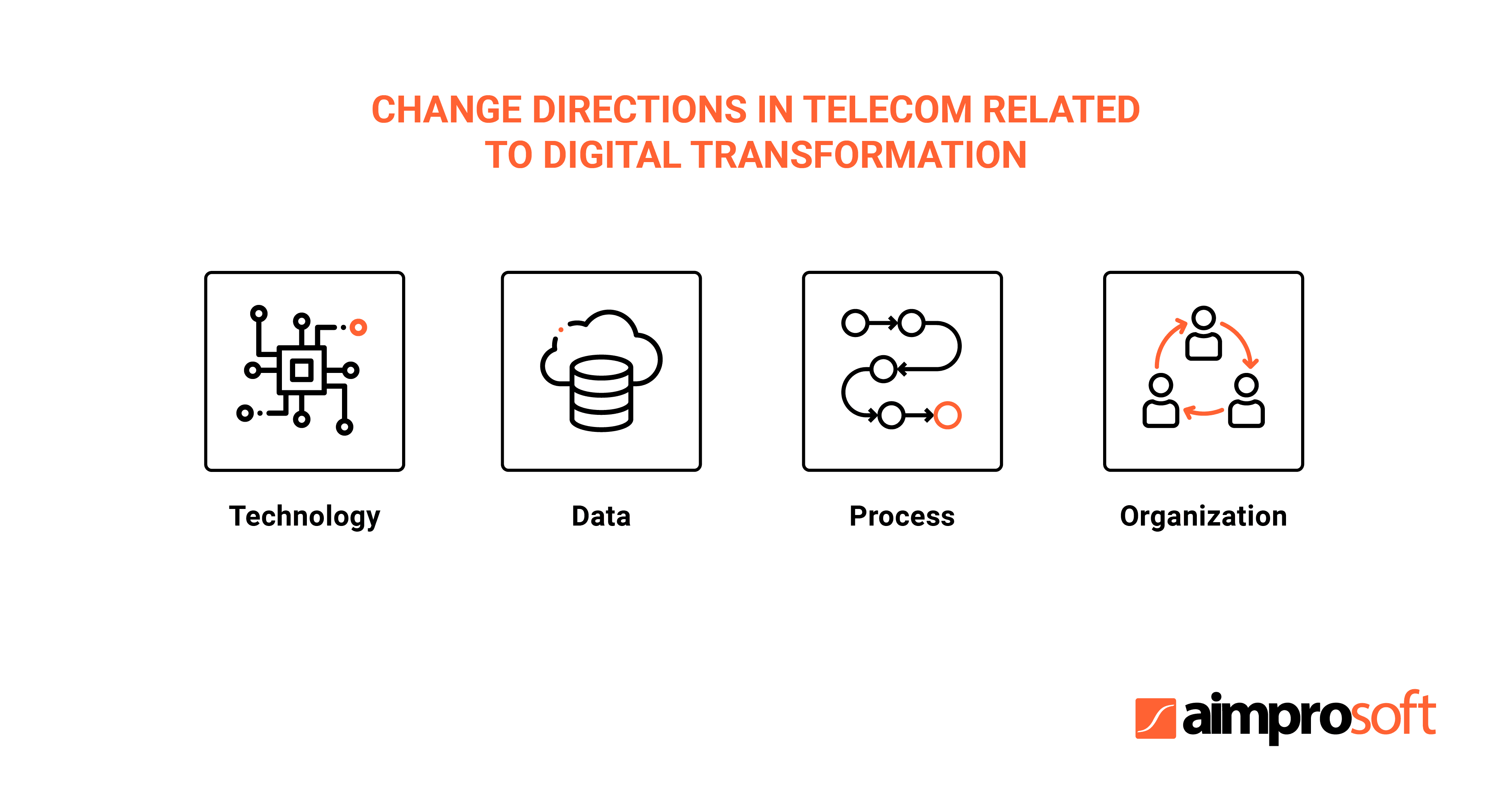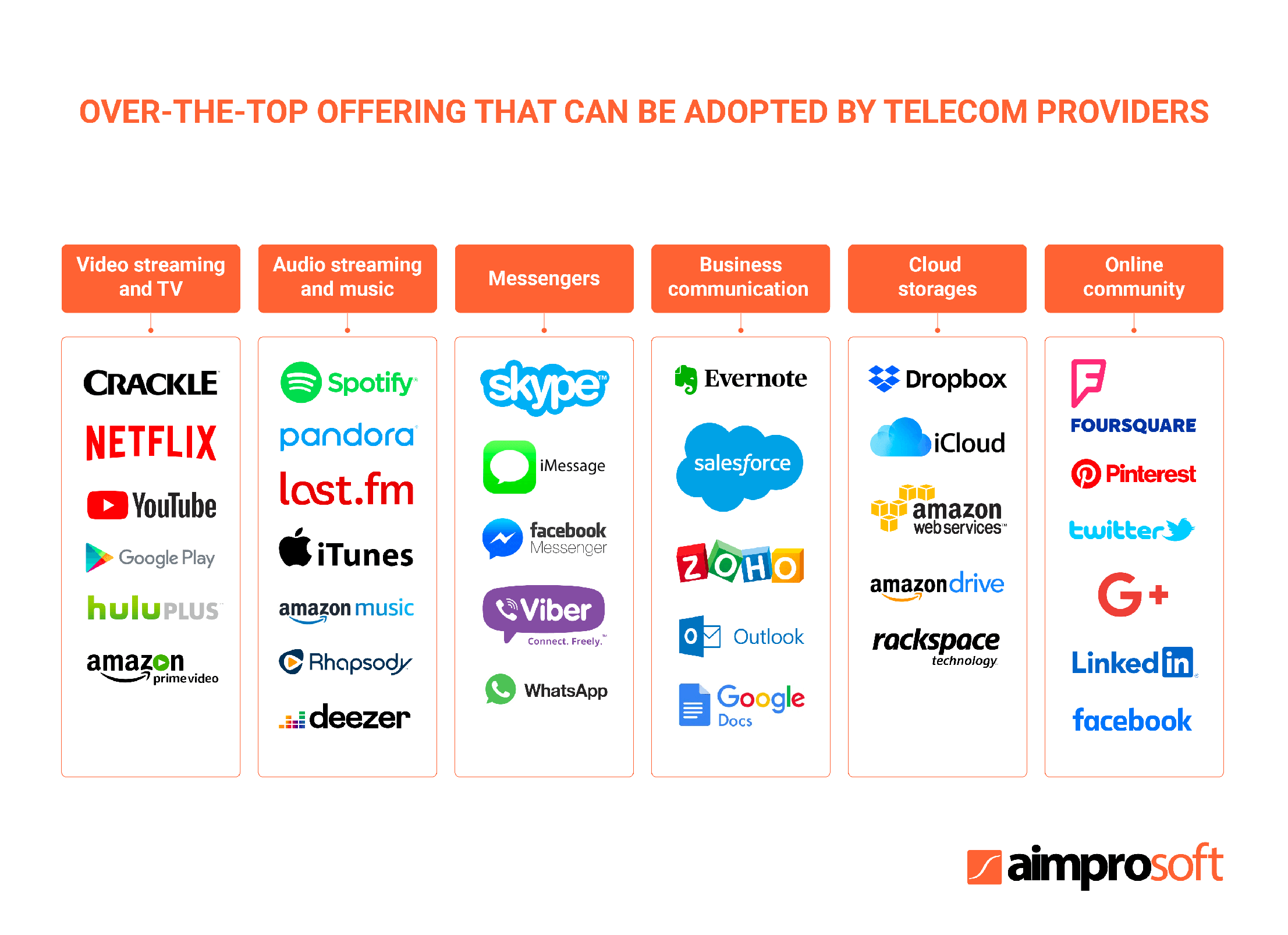Digital Transformation in the Telecom Market

Key takeaways
-
Discover new opportunities that are open due to digitization in the telecom industry and why we’re talking about $6.8 trillion spendings on transformation.
-
Systems and processes changes of the new age: find out in advance what obstacles the industry faces in spite of promising relief.
-
Telecom doesn’t live by 5G alone: know more trending directions of great expectation.
-
Find out benefits from digital transformation for CSPs emerging from unexpected sources of revenue and new markets.
-
Read how the operating UK telecom provider became a leader in the industry: our transformation case.
Throughout the pandemic, everyone has been keenly feeling a necessity for close access to each other. After such strict restrictions, the time of easing is expected with the hope of getting back on track. But still, digitalization in telecom costs skyrocketed $6.8 trillion by the most favorable forecasts, which means the industry isn’t going to give up the piece of the market pie driving people to live in a new ecosystem of values.
Keep on reading about the digital opportunities in telecom — a trillion-dollar market today.
What is digital transformation in the telecom industry?
Business finds themselves in fast and furious conditions. Initiatives pass the way from demand to implementation in a couple of days instead of months as in prior times.
If earlier the mobile Internet was mainly entertainment, today it is of utter importance for education, healthcare, private communication, and other fundamental areas of our life. The pandemic has become a growth driver for telecom companies and forced them to launch products on a tight schedule.
The main driver of changes in the past-COVID world is a digital consumer. Clients’ preferences are moving at a greater speed, higher requirements to quality, products functionality and design. Impressions are important to a consumer. Consumer models are changing followed by emerging a new evident trend interconnection via smart devices.

So what is digital transformation in telecom? Where does it spend that kind of money? And what actually is underway of transformation?
Digital transformation in the telecom industry is a natural process of integrating digital technologies across the entire business to step up the market challenges on the way of achieving customer satisfaction. It represents a mix of hardware and software improvements.
The transformation directions that set the tone are:
- Technology emergency. AT&T Inc. and Verizon Communications started 2021 with $70 bln combined investments on the 5G spectrum.
- Innovative standards for hardware with the goal to meet all aspects of the society and entrepreneurship needs.
- Software upgrade subsequently going to ensure billing business processes, customer care, and other process management needs.
- Telecom service providers: legacy referred to ‘communications’ (CSPs) pass away letting new ‘digital’ take up the cause.
- End-customer and B2B accounts improvements follow forcing by the drivers above.

What are the main challenges in digital transformation for telcos?
Talking about challenges in telecom, we’d like to highlight two burdens: digital transformation in the telecommunications industry refers to the renewal of infrastructure systems and business processes.
Legacy business models and IT infrastructures lead to a shortage of telecom competencies which hampers responding to customer demands. Customer, partner, and resource relationships managed in an old-fashioned way require integrating automated solutions to replace manual tasks of inserting separate data into a single system.
The much-talked-about 5G network infrastructure requires NFV/SDN (network functions virtualization and software-defined networking) to deliver digital services. Greater amounts of mobile data consumption, especially high-resolution video content, necessitate the digital transformation for telcos to enable fast data transmission with new communication standards.
Telecom drives the Internet of Things that, in its turn, expands the landscape of security issues concerning tech stack, security systems, data, processes, partnership relations, and digital infrastructure as a whole.
Telcos step into a digital economy ahead of other industries. Generating, transmitting, and storing a threatening amount of data leads to the need for digital transformation for telecom operators so that they can cope with the data.
Prior to following the road of digitization, telcos used desktop applications delivering a limited package of services to the limited list of customers. They were not supposed to be interacted with in any way, and it hindered scaling portfolio services comparatively to the over-the-top (OTT) companies.
Sales channels are undergoing transformation by the same token. ‘Multiple’ has already been akin to ‘digital’ because the latter opens more opportunities for business offering and interactions with customers and partners beyond traditional norms.
Close to service distribution and stakeholder interactions, there is a limited customer experience. Those that weren’t affected by telecom digital transformation yet, experience slower customer engagement and less trust.
What are the current trends of digitalization in telecom?
Experts state that 5G, the Internet of Things, and Big Data analysis, shift to the cloud, and an as-a-service model will be the foundation of the digital economy, with the leading software driving force being Artificial Intelligence.
So here we’ve got to the hottest topic.
A demand for more bandwidth has been snowballing when the whole world became using videoconferencing, telemedicine, to learn online, buy online driving a 22% up global retail sales growth ($4.28 trillion) while the telecom services sales went up to $1.55 trillion in 2020, making it the most resilient industry against the backdrop of the corona crisis.
Several key digital trends have emerged in the telecom industry during the pandemic, putting telecom on target to create new features for business telephony that became essential rather than the convenience of remote communication.
5G
5G is rightly described as a foundation of the digital economy. This promising technology won the hearts of investors with its opportunities as a new technological revolution and attractive dividends expected to be. Its network speed is up to 100 times higher than 4G, which is its mere basic capability, while the integration of computing and storage is considered the main feature.
Internet of Things
Redirection of resources to potential development areas with the expected growth and reduction of investments in basic IT infrastructure is a point of discussion for many leaders here to stay. Trending solutions such as the Internet of Things, the AI and ML pair, are now coming to the fore as never before.
Smart homes and cities, the Internet of Things, and other technologies of mass consumption will reach a qualitatively new level. Implementation of 5G will lead to a network capacity increase, making it possible to use a larger number of devices per unit area. The number of SIM smart devices has already prevailed over traditional SIM card usage in the world, which is going beyond communication services, Internet access, and traditional telecommunication services. Hence, telcos’ offering is headily expanding with IoT business use-cases.

Machine Learning and Artificial Intelligence
The proliferation of ML and AI is related to the demand to process enormous business data possessed from customer activities, smart devices, predictive analytics, robotization, predictive network maintenance, and improvement is the case. It resulted in the demand for intense advanced data analytics.
Analytics
Advanced data analytics don’t give places to others, having a special focus on the Internet of Behaviors (IoB) there which goes next to the real-time analysis of consumer actions interpreting personal device usage, online payments, mobile internet surfing, etc. Gartner predicts that IoB programs will touch over half of the population by 2025, where telecom will have a big part.
Right analytics applications can boost enterprise performance. We shared our insights.
Cloudification
Read the main article: Cloud Computing for the Telecom IndustryDigital transformation in the telecom market is characterized by active money inflows in the development of cloud services, which has proven to be the most reliable solution in today’s environment. Earlier cloudification penetrated internal infrastructure, rising to prominence as the reliable solution entailing a move of business support systems in clouds as well.
Microservices
And sure, CSPs move toward architecture to maintain and manage large systems becoming overgrowing with features year over year. To the arena will arrive microservices devoted to spreading the operational load of massive applications across different mini-modules responsible for individual functions. AT&T, Telefonica, BT, and CenturyLink have already adopted a new architectural style for a good reason.
Cybersecurity
Cyber information security is a business in which telcos see great prospects in their strategy for 2021. During the pandemic in January and April, cloud infrastrures experienced a 630% rise in hacker attacks. The cybersecurity mesh is already in high demand and is practiced in cloud-located web and mobile applications to control secure access to data.
All trends are tightly connected with the rising necessity of qualified software developers that Aimprosoft can cover.
What are the benefits of digital transformation?
Having gone through challenges and followed trends, there’s an interesting pattern with benefits from digital solutions for telecom.
5G‘s characteristics will allow communication networks to transform into providers of virtual core networks and cloud architecture, as well as provide advanced data processing capabilities. 5G will tackle the challenge of offloading 4G networks tested in light of exponential traffic growth.
Advanced attack-stable security measures will bring to telecom an additional business opportunity to offer cybersecurity services while settling adjacent markets. Telecom companies had become a main authoritative source of authorization before we even knew it. According to Martijn Verbree, Partner KPMG in the UK, it is an excellent opportunity to add extra value and differentiate themselves in the market.
Presently automation technology based on AI paired with Big Data analysis can improve the digital customer experience in telecom with granular insights gaining a 360-view of the customer. Telcos will be rewarded with warnings of peak network usage, exacerbating churn customers, and billing issues, which will help avoid difficulties cutting down on the guesswork.
Artificial intelligence has a meaningful impact on people’s life—your customers.
Business operations that are cloudified avoid hyperscale telcos workloads. Now when the telecom industry plays a key role in providing value-added services to society and enters the 5G adoption era, clouds will reward them with greater bandwidth and access to computing power. Cloudification saves economies of scale from enormous spendings due to its scalability, higher agility, and innovative approach in service delivery.
IoT is the most desirable direction in capitalization for telecom operators, considering that IoT in the healthcare market alone will be worth $176.82 bln by 2026. Identically, the automotive industry can bring them revenue from building the autonomous vehicle ecosystem with telematics-associated options. Smart city and smart home infrastructure supplements with but still don’t complete the full reward set from IoT.
AI is at the heart of personal assistants and chatbots in business communication, and simultaneously it performs network analytics insights transforming the huge datasets to improve efficiency. Jointly with ML algorithms, AI is applied to detect fraudulent activity, monitor operations, and make a company a truly data-driven enterprise.
Microservices will help cope with the complexity of the 5G ecosystem. This is, probably, the main advantage for this situation. In like manner, decentralization of the entire application complex brings telecom providers increased resilience, minimizing failure impact to nothing. Savings come with scalability when changes can be applied to a single service rather than the application.
As a natural corollary, transformation influences the appearance of over-the-top content (OTT) delivered over the Internet which digital telcos support in their portfolios already.

Challenges, trends, and benefits of digital transformation in the telecom market
| Market demand and challenges | Solutions and opportunities | Positive benefits |
|---|---|---|
|
Transfer from ‘communication’ (CSP) to ‘digital’ (DSP) service providing over-the-top content (OTT) |
|
|
5G is an expensive tech relief but with greater return on investment brings AI and ML as a power of smart decisions |
|
|
Cloudification of internal and external operations is obvious and irrevocable for providers of value-added services |
|
|
Data analytics with the Internet of Behaviors (IoB) |
|
|
Internet of Things as a natural cause of telecom software development |
|
|
Big Data as a trend detector |
|
|
Cyber security practice for cloud-based infrustructures |
|
|
Open API platform architecture |
|
|
Microservices and containerization keeps up telcos with current development trends |
|
|
360-degree omnichannel customer experience |
|
Tech stack and our experience in telecom digital transformation
A national coverage estimated as 75% of all UK businesses is reached by diligent and smart work.
Virtual1 is a result of a partnership lasting over 10 years. Aimprosoft has been performing digital transformation for a telecom operator with a Java-based web portal for wholesaling telecommunication services with Liferay DXP in its core. B2B distributing corporate and self-service portals as a part of Virtual1’s growth strategy strengthened relationships between stakeholders.
Our cooperation resulted in the infrastructure where managing the distribution of the telecommunication services has become as easy as selling a single tangible product.
Conclusion
Users have already tried the digital lifestyle and felt that many issues could be solved online, the patterns of human behavior have changed. Therefore, market players should continue to adhere to the digital course set in 2020. The topic is quite extensive, so we invite you to have a private talk about transformation initiatives essential for your business in adaptation to the high rate of market changes and the new requirements of the digital consumer.




